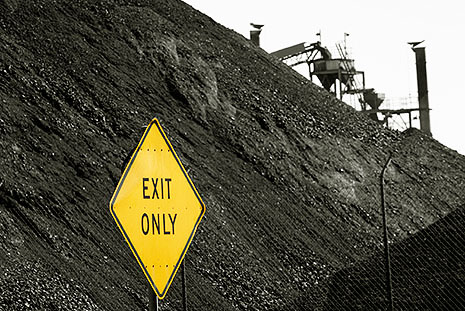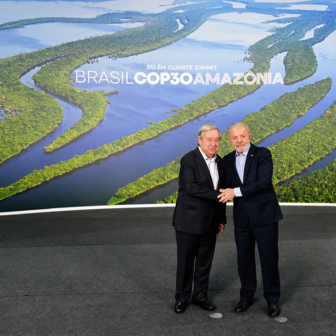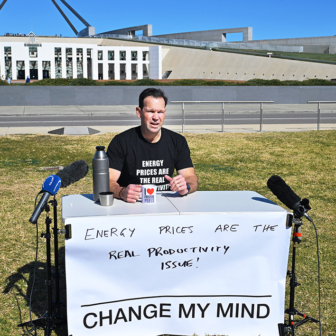IF THERE was one true loser at the 2013 election – apart from the Labor Party – it would have to be the climate. After six years at the top of the national agenda, climate change was nowhere to be seen during the campaign. Labor was desperate to avoid the issue and the Coalition wanted to talk about it only in order to attack the carbon price. Just one climate organisation seemed to promote the issue vigorously – WWF, with their somewhat lacklustre “I am real” campaign.
And you can see why. Since its peak in 2006, support for action on climate change has steadily decreased. The carbon price remains unpopular, with Tony Abbott’s attacks on its introduction seen as one of the key reasons for the drop in Labor’s support. After successfully getting climate change onto the national agenda in the lead-up to the 2007 election, the climate movement is now losing the debate. And something has to be done to win it back.
It would be easy to blame specific circumstances for this conundrum: the failure of Copenhagen, the dumping of Rudd’s Carbon Pollution Reduction Scheme, Julia Gillard’s “great lie” about a carbon tax and the ferocious campaign by Tony Abbott to destroy her prime ministership over the issue.
But this misses the point. The recent downturn in support for climate action is part of a long-term failure by the climate change movement to frame the debate on the issue effectively.
The problem goes back to the origins of the movement, after global warming first appeared on the scientific agenda in the late seventies and early eighties. The first international scientific conference to express concern about the link between greenhouse gasses and warming, the World Climate Conference, was held in Geneva in 1979; it was followed by the first UN conference in Austria in 1985 and Australia’s first major climate conference, Greenhouse 87, hosted by the CSIRO, in 1987.
Around the world scientists were raising the alarm, and their concerns cut through. In 1988 the international community set its first emissions target, the “Toronto targets,” which called for a 20 per cent cut in greenhouse gas emissions on a 1988 level by 2005. In 1990, the Hawke government agreed to these cuts (although that agreement was reversed after Paul Keating became prime minister). For an issue that had only been on the agenda for a decade, these were significant achievements.
Importantly, though, they occurred largely in the absence of the environment movement. As sociologists Jan Pakulski, Bruce Tranter and Stephen Crook write, “While the public at large expressed concern mainly about what we termed the ‘brown’ issues of pollution and waste disposal, the more environmentally active Australians, especially members and activists of environmental groups, were more concerned about the ‘green’ issues of logging native forests and fauna/flora depletion.” Climate change was the purview of scientists and the media; the environment movement stuck to protecting wilderness areas.
In this sense, climate activism harked back to the Enlightenment – the period from the seventeenth century that saw the development of the first scientific societies, and the eventual replacement of disciplines like astrology and alchemy with more solidly based scientific practice. One of the best-known scientific theorists, Francis Bacon, developed the idea of a scientific practice based on three characteristics: authority created by a process of hypotheses and empirical confirmation; an emphasis on method and mathematical formalisation; and methods and perspectives transformed and institutionalised through the progressive development of improved theories and practices.
Science became a “mode of thought” that emphasised the human capacity for rational and objective thought, and this mode of thought has dominated much of politics ever since. Discussing the American context in his book The Political Mind, linguist George Lakoff argues, “Progressives have accepted an old view of reason, dating back to the Enlightenment, namely that reason is conscious, literal, logical, universal, unemotional, disembodied, and serves self-interest.”
In the 1990s, when the environment movement began engaging with broader issues of sustainability (following the Brundtland report in 1987) and then climate change (after the rise of the fossil fuel lobby in the early nineties), it worked within this tradition. Writing in 1997, Phil Macnaghten and Michael Jacobs described it as the “dominant view of sustainable development” within which people “are presented as individual agents acting ‘rationally’ in response to information made available to them. Ignorance about environmental issues can be rectified by the provision of information; information will engender concern; and concern will translate into both personal and political behaviour changes.”
In this paradigm, sustainability is achieved by providing rational actors with information about the destruction of the environment, which they will then act on. Science communicators call this the “deficit model” of communication; once people know about climate change, they will take action to deal with it.
This belief played out in the way the climate movement engaged with the issue. First, climate activists focused their efforts on trying to “educate” the public about climate-change science in order for them to take action. As researcher Harriet Bulkeley noted after interviewing staff of Greenpeace, the Australian Conservation Foundation and other organisations:
Throughout the Australian climate-change policy network, the scientifically determined risks that climate change poses, and the illiteracy of the public over those risks, is emphasised, albeit with different policy prescriptions, to justify educating or ignoring the public. The apparent lack of public concern for the issue is attributed to their lack of knowledge of the risks, due to the complexity and global scale of the issue, the extent of publicised scientific uncertainty and confusion, and its irrelevance to their daily lives.
These campaigns were often a reaction to attacks on climate science by the fossil fuel industry, but they became a fundamental feature of climate campaigning.
In these early stages of the movement, scientists left policy-making to liberal economists and the movement focused on persuading individuals to take action. As Tad Tietze and Elizabeth Humphrys argue in the recent book Left Turn:
Scientists understandably provided little guidance to how climate action could be achieved. Official responses tended to be written by environmental economists, whose ideas are overwhelmingly shaped by the “neoclassical” discourse dominant in government and business circles for the last thirty years. Market liberalism has come to narrowly define both the problem and possible solutions.
This market approach is built on a second strand to emerge from the Enlightenment, the liberal ideology that emphasises the individual and sees only a limited role for government. At the community level, it translated into campaigns to get people to take personal action on the issue – with Earth Hour being the greatest example. At a government level, it meant supporting neoliberal emission trading schemes, such as the Carbon Pollution Reduction Scheme and Clean Energy Packages introduced by Labor.
THE problem with this sort of approach is that it doesn’t work. There are many critiques of how individual/neoliberal policies have been used for climate action (see here, here and here), but it is their very basis that has caused the real problems for the climate movement.
The key problem is that the human brain doesn’t work in the way the Enlightenment theories tell us it does. It is not wholly rational and logical and doesn’t react to information campaigns in the ways desired by the movement. As Lakoff argues in The Political Mind, reason is physical, mostly unconscious, metaphorical, emotion-laden and tied to empathy.
Science communicators have understood this for quite some time, and have seen the impact this has on science communication campaigns. “Despite the continued reliance on information campaigns to mobilise action,” social scientists Johanna Wolf and Susanne Moser explain, “communication research has largely dispelled the information-deficit model of environmental education and communication. More knowledge of a problem does not necessarily, directly, and by itself lead to a change in behaviour, and sometimes it can actually hinder behaviour change.”
There are a number of reasons for this gap between environmental awareness and action. First, the evidence suggests that people will take action only if other factors come into play: knowledge of action strategies, a sense that actions can bring change, pre-existing environmental attitudes, a verbal commitment and a sense of responsibility. Equally, there are factors that can limit people’s desire to take action, including demographics, whether institutions support individual action, whether people can afford to take action, and whether people feel socially supported to take action. Other factors – motivation, environmental knowledge and values – are also important.
Putting these factors together, it can be difficult for people to connect to climate change. For Susanne Moser, for example, the lack of engagement reflects factors including the complexity and uncertainty of the science and the lack of day-to-day events that indicate a need for change.
Psychologists Ezra Markowitz and Azim Shariff build on this by arguing that we’ve failed to turn climate change into a moral issue. They contend that (1) climate change is seen as abstract and complex, (2) campaigns have failed to identify the “enemy” that people can campaign against, (3) individual-focused campaigns have caused guilt as people see themselves as to blame, (4) the impacts of climate change are uncertain and far away (both in the future and in distance), and (5) campaigns have connected almost solely with progressive audiences, leaving conservatives isolated.
Take a look at what has probably been the most prominent climate campaign over the last six years, the Say Yes Australia campaign, and you see these problems. The campaign focused on the idea of Australia “saying yes” to a carbon price, but was disconnected from people’s real lives. It was run before any policy was developed, which meant that people were campaigning for an abstract, non-existent thing. And while we were being asked to “say yes,” the campaign didn’t articulate who the opposition was – who was saying “no” and needed to be opposed. For some critics, the decision to use multimillionaire Cate Blanchett in the campaign further disconnected the campaign from people’s lives. And finally, it was largely disconnected from grassroots activists, with many arguing that the techniques used isolated the movement from the community.
And so we can see what has happened over the past six years. As climate legislation has been introduced by the Labor government, opposition to it has been ferocious – at first from the carbon lobby, and since 2009 from the Coalition. And in attacking the legislation the Coalition tapped directly into people’s values and fears – fears that it will cost huge amounts of money, and the values of looking after our family and community. But the movement has not reacted strongly to these attacks. It has stuck to a rational approach, in turn buying into the very problems that communicators identify with the issue of climate change.
WHERE to from here? With the Coalition taking government it would be natural for the climate movement to focus wholly on defending the carbon price. Yet this strategy is not necessarily a wise one – and it is here that Tony Abbott can be instructive.
It’s time for the climate movement to adopt Abbott’s “direct action” motto. That doesn’t mean agreeing to Abbott’s deeply flawed direct policy plan. Instead, a direct action strategy should focus on reframing the debate.
“To change minds, you must change brains,” George Lakoff argued in The Political Mind. “You must make unconscious politics conscious.” To change opinions and to effect change, we must tap into people’s values and morals. We must treat people as the values- and morals-based beings they are, and not simply as “rational actors” always working in their self-interest. And to do this we need to understand how values work, something the climate movement has rarely tried to do.
Values are the way the brain represents desirable, abstract and trans-situational goals that serve as guiding principles in people’s lives. In other words, values are (1) our goals, (2) what we consider important in our life, and (3) our standards for judging behaviour, events and people. Values therefore have a direct impact on how individuals and societies make decisions. They define how we get along with each other, how we manage our affairs and how we develop relationships with each other and the world. They are a primary driver in political and policy decision-making and an essential element in understanding the passion behind politics.
Importantly for the climate-change movement, human values are often contradictory. Social psychologist Shalom Schwartz has derived ten basic values that form what he calls the universal requirements of the human condition: power, achievement, hedonism, stimulation, self direction, universalism, benevolence, tradition, conformity and security. Because these values are inherently contradictory, our social, economic and political systems are determined by which of them are dominant at any particular time.
To win the climate debate, we must win the values debate. Ezra Markowitz and Azim Shariff argue that to do this we must turn climate change into a “moral issue.” They suggest six strategies that the movement can use to do this: (1) framing climate change in a way that appeals to people’s current values, (2) focusing messages on the burdens climate change may impose on future generations, (3) motivating people through appeals to hope, pride and gratitude rather than guilt, shame and anxiety (points two and three are somewhat contradictory, and require a nuanced message that points out the burdens but does not make people feel guilty for them and instead builds pride in the idea of taking action), (4) being wary of “extrinsic motivators” – for example, attempts to push action because it will be “good for business,” (5) increasing identification with and empathy for those impacted by climate change now and in the future, and (6) highlighting positive social norms – or, in other words, using peer pressure to get people to take action.
These tactics are designed to make climate change a moral issue – to tap into people’s values to encourage action.
Some organisations are already using these ideas, and it seems to be working. The international organisation 350.org, with which I am involved, was founded by environmentalist Bill McKibben, who gained a degree of notoriety after he published an article in Rolling Stone in 2012 called “Global Warming’s Terrifying New Math.” There, he discussed new research showing that fossil fuel companies have five times the amount of carbon stored in already-valued reserves than scientists say it is safe to emit into our atmosphere.
But it wasn’t the science that made the article so notable, it was the reframing of the debate. McKibben turned climate change into the values-based debate it should be. He did this first by identifying the true enemy of our climate.
“What all these climate numbers make painfully, usefully clear,” McKibben wrote, “is that the planet does indeed have an enemy – one far more committed to action than governments or individuals. Given this hard math, we need to view the fossil-fuel industry in a new light. It has become a rogue industry, reckless like no other force on Earth. It is Public Enemy Number One to the survival of our planetary civilisation.”
Research shows that one of the key problems with climate-change communication is that the individual focus has made people see themselves as the cause of the problem. People then go into denial over both the science and their role in climate change in order to avoid the guilt they feel. Given that individual actions are very unlikely to significantly help solve the problem, a focus on a real enemy is sorely needed – and it is clear that the fossil fuel industry is that enemy.
The next step is to highlight the impact or burden of climate change – the burden the fossil fuel industry is placing onto everyone. And the way to do that is to focus on real-life effects, not on effects that are too distant for people to experience. Many, including McKibben, are now starting to use extreme weather events to show these direct impacts, particularly as science is now able to link particular events to climate change. In doing so we create empathy with those who are affected by climate change, with extreme weather events in particular connecting people with those who are closer to home.
Finally, we need to provide the solutions, and encourage pride in people adopting these sorts of solutions – whether it is adopting renewable energies or getting involved in climate campaigns. With advances in renewable energies, and the greater uptake of these technologies, these solutions are becoming easier to identify and promote.
What we’re doing here is shifting the climate debate from an indirect approach – one that tells people the science and hopes they make up their own conclusions – to one that targets the cause and impact of the problem and outlines solutions. Instead of making climate change a scientific problem, we shift it into a problem of values, by connecting people to those of their own values that are conducive to climate action (care for others, for example) and downplaying other values that are holding back action (consumerism).
So the story is relatively simple – climate change is here, it is caused by the fossil fuel industry, it is affecting individuals directly, and here are the solutions. Once you show what can be done – whether it’s getting involved in movements to oppose fossil fuel projects, for example, or getting organisations to divest money from the fossil fuel industry – you have provided direct links between the story, the individual and our community.
This is what I would call a direct action approach. It taps directly into people’s values. More importantly, it targets the problem and solution effectively – giving people a direct path between the problem presented and what they can do about it.
With Tony Abbott as prime minister, climate campaigners could feel despondent about the next three years. But his election is both a wake-up call and an opportunity for the movement to change its tactics and the way it makes change. We may have lost the latest small battle, but this is how we can ensure we win the war. •




